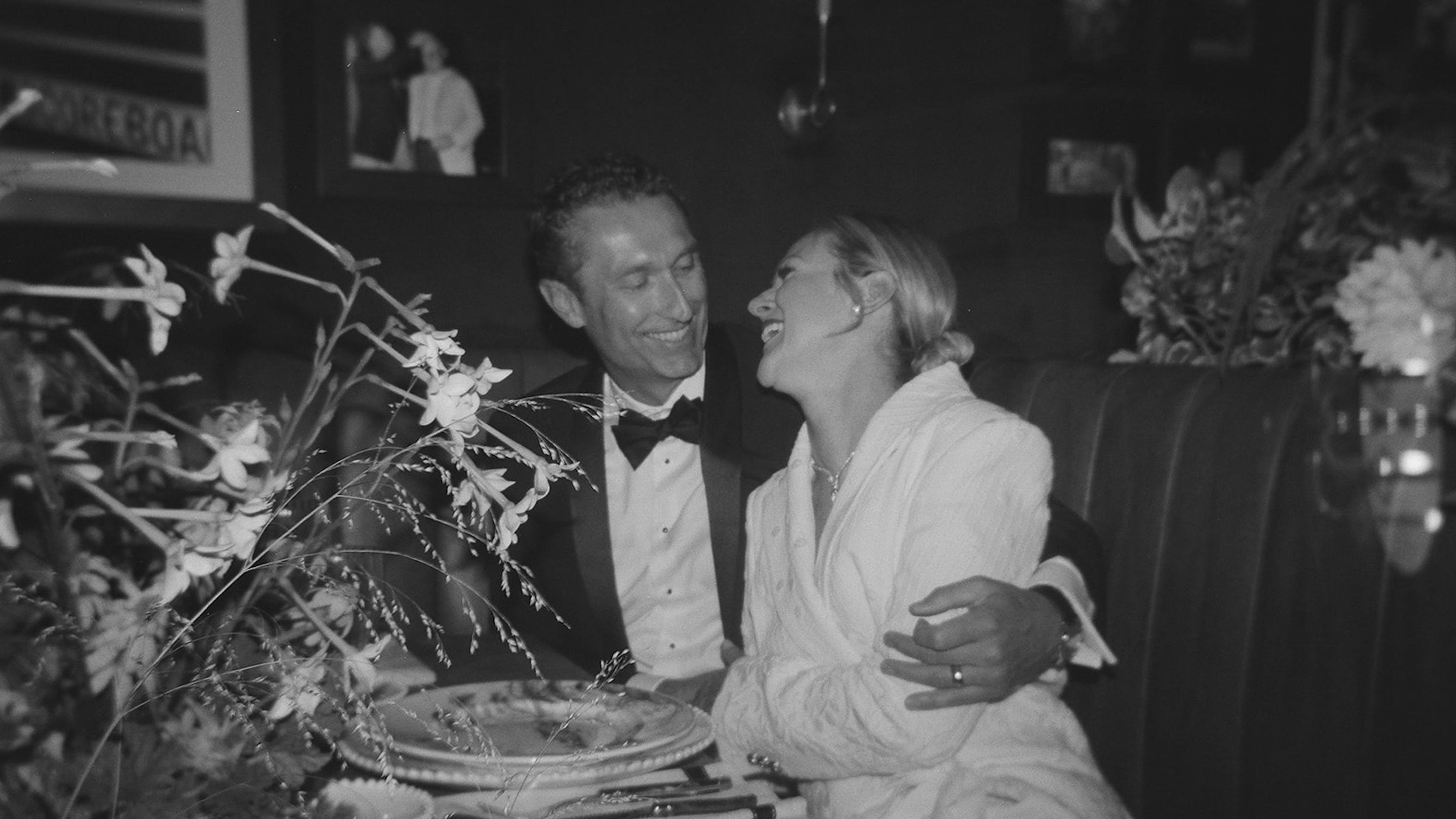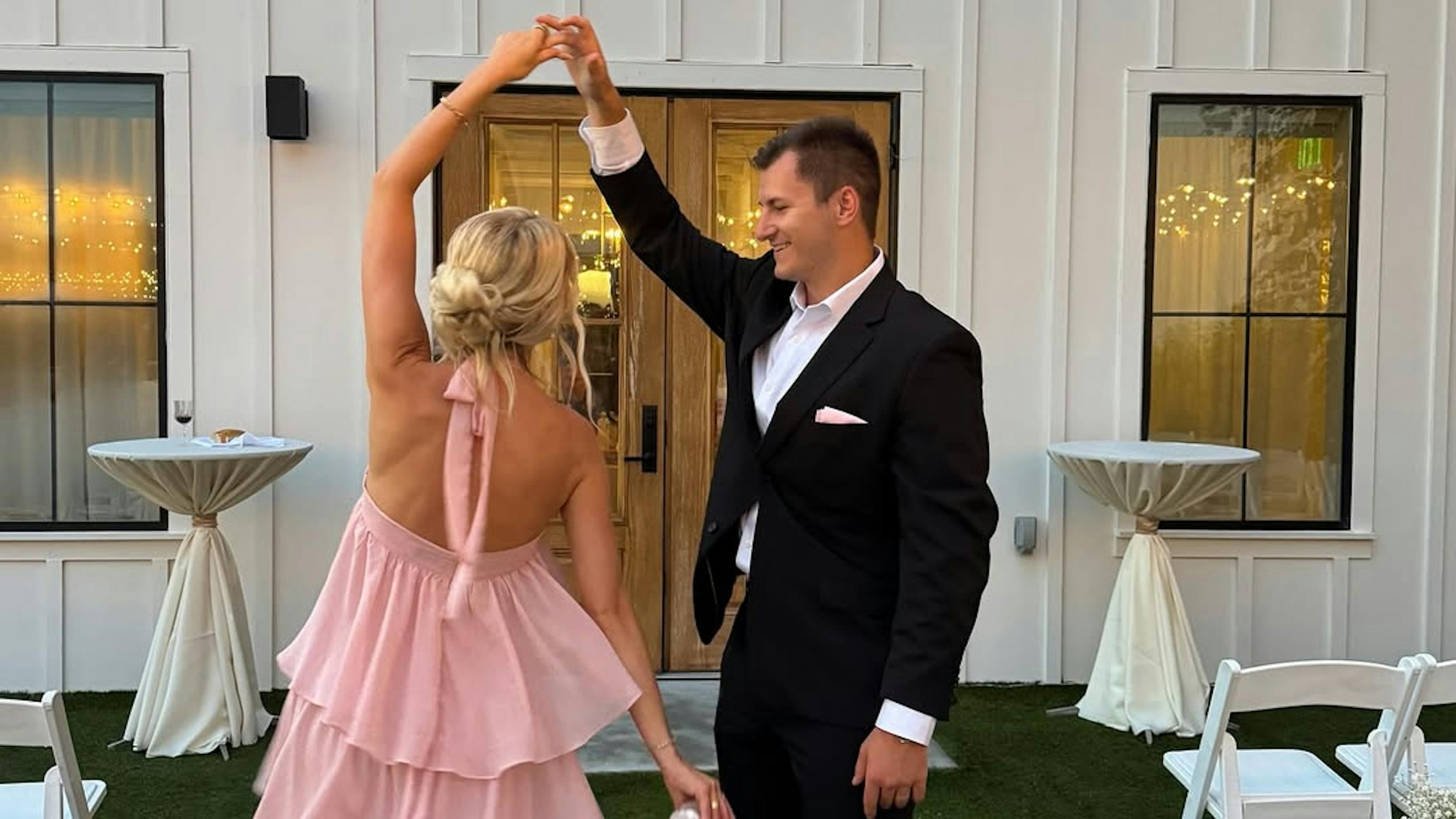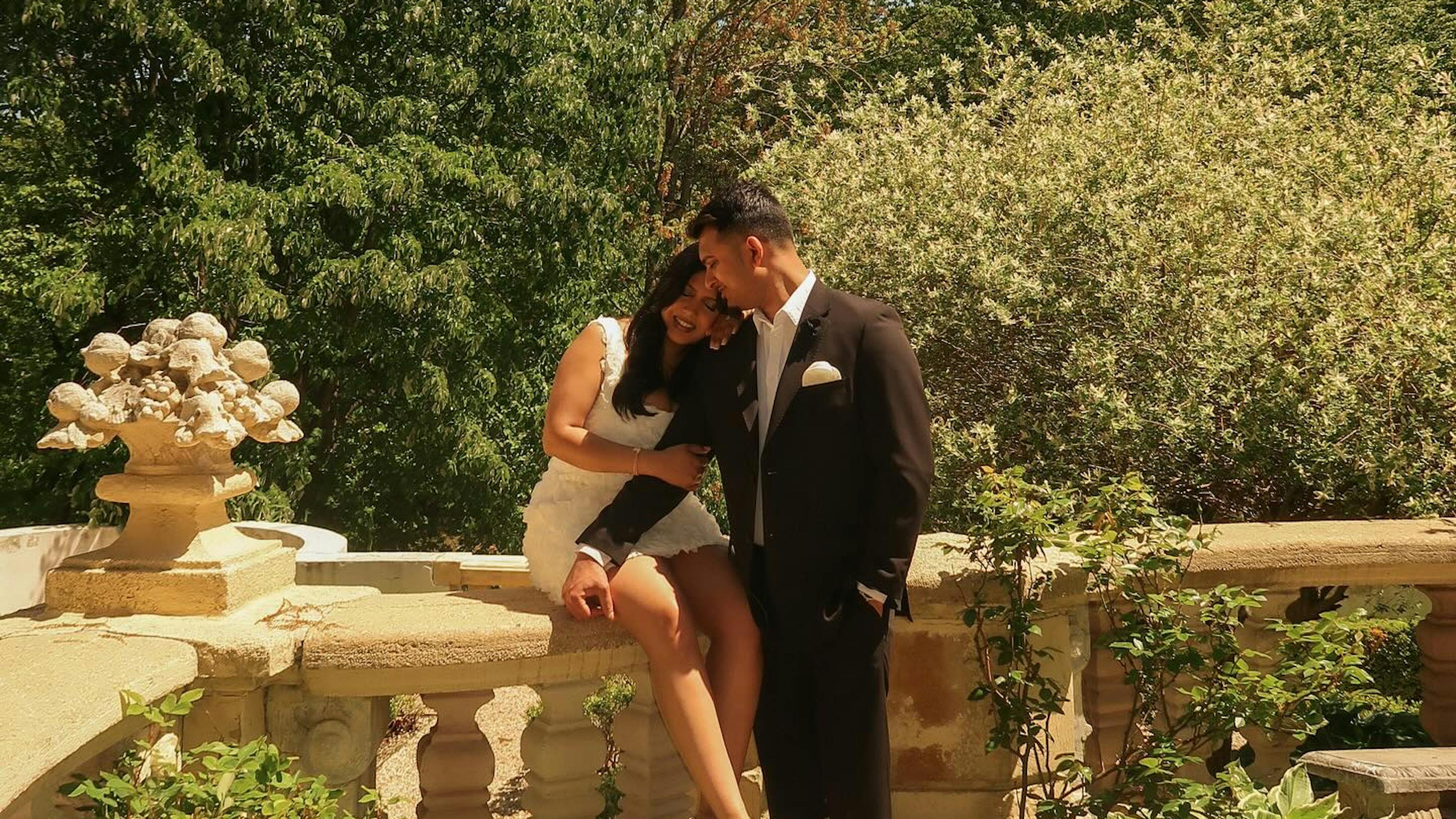How to Pin a Boutonniere: Perfect Placement in 3 Easy Steps
Published on November 7, 2017 | Updated May 9, 2024
By Diana GanzWhat Is a Boutonnière and How Do You Wear One?
One of the most common mistakes men make when getting ready on their big day is poor boutonniere placement. We’ve seen it everywhere from the center of their lapel to inside the front pocket of their jacket. When you think about it, it’s understandable that this may be confusing. After all, how often do you wear a boutonniere? Maybe a couple times a year if you’re a party animal, but most will only wear a boutonniere a few times in their lifetime. All it takes is one person to be an expert in boutonniere placement and after this article, you’ll be that guy.
Key Takeaways
- Boutonnières are small floral arrangements worn by men on the lapel of a jacket. They add sophistication and style to formal occasions like weddings, proms, and galas.
- Boutonnières are traditionally worn on the left lapel, slightly above the heart.
- Boutonnière costs varies depending on factors like flower type and design complexity, typically ranging from $10 to $20.
- Pairing a boutonnière with a pocket square can elevate your formal ensemble; coordinate colors and fabrics for a cohesive look.
What Is a Boutonnière?
A boutonnière is a small floral decoration typically worn by men on the lapel of a suit or tuxedo jacket. It's commonly seen at formal events such as weddings, proms, or other special occasions. The word "boutonnière" is French and originally referred to the buttonhole where the stem of the flower goes.
Centuries ago in Europe, guys were already on the boutonnière trend. They'd jazz up their jackets with tiny flowers, herbs, or other natural elements they could find to look classy and slick. Initially, these floral decorations served practical purposes, such as masking body odor or warding off evil spirits. But over time, they evolved into accessories worn for style.
Nowadays, boutonnières are still going strong, but they're more about adding a bit of flair to your formalwear. Whether you're attending a wedding or a fancy gala, these small but impactful floral accents bring a splash of color and personality to your outfit. You can keep it simple with a single bloom or go all out with a fancy arrangement of flowers, leaves, and maybe even some cool pins.
So, next time you suit up for a special occasion, don't forget to throw on a boutonnière. It's a small touch that packs a big punch in the style department.
What Are the Different Types of Boutonnières?
When it comes to boutonnières, the options are endless, allowing you to add a personal touch to your formal attire. From classic floral designs to more unconventional styles, there's something to suit every taste and occasion.
- Flower Boutonnières: These are the classics. A single bloom or a small cluster of flowers pinned to your lapel can instantly elevate your look. Roses, carnations, and lilies are popular choices, but feel free to get creative with seasonal blooms or your favorite flowers.
- Fabric Boutonnières: If you're looking for something a bit more durable or long-lasting, fabric boutonnières are a great option. These can be made from various materials like silk, satin, or even lace, adding a touch of texture and elegance to your ensemble.
- Feather Boutonnières: For a unique and eye-catching accessory, consider a boutonnière made from feathers. Whether you opt for natural feathers or brightly colored ones, they're sure to make a statement and add a playful twist to your outfit.
- Theme-Specific Boutonnières: You can also search for or create theme-specific boutonnières that tie into the theme of the event. Whether it's a rustic wedding, a beachside event, or a vintage-inspired party, you can tailor your boutonnière to match the vibe perfectly.
- DIY Boutonnières: Feeling crafty? Consider making your own boutonnière. With a little creativity and some basic supplies like flowers, greenery, and pins, you can design a custom boutonnière that reflects your personal style and flair. Plus, it adds a special touch knowing you made it yourself.
What Side Does a Boutonnière Go On?
Traditionally, a boutonnière is worn on the left side of the jacket lapel, positioned slightly above the heart. This placement not only looks great but also allows the boutonnière to be easily seen and appreciated. It's a small detail, but getting it right adds a polished touch to your overall look.
How Do You Pin a Boutonnière?
Pinning a boutonnière may seem like a small detail, but getting it right can make a big difference in your overall appearance. Whether you're attending a wedding, prom, or any formal event, knowing how to properly pin a boutonnière ensures that it stays securely in place throughout the occasion. Below, we'll walk through the steps to pinning a boutonnière so you can nail that dapper look with confidence.
1. Find the right placement
The key to wearing a boutonniere is proper placement. Boutonnieres are always placed on the left lapel of your jacket. Almost all suit lapels will have a button hole which makes finding the right spot really easy as the boutonniere will be placed directly over it. Specifically, the largest part of the flower will be placed over the hole with the base of the flower where the ribbon covered stem begins laying on the lapel below the button hole. The stem of the boutonniere should be aligned with the sides of the lapel so it angles in the same direction. Fun Fact: Boutonniere is French for button hole which was originally designed to let men stick single flowers through their lapel.
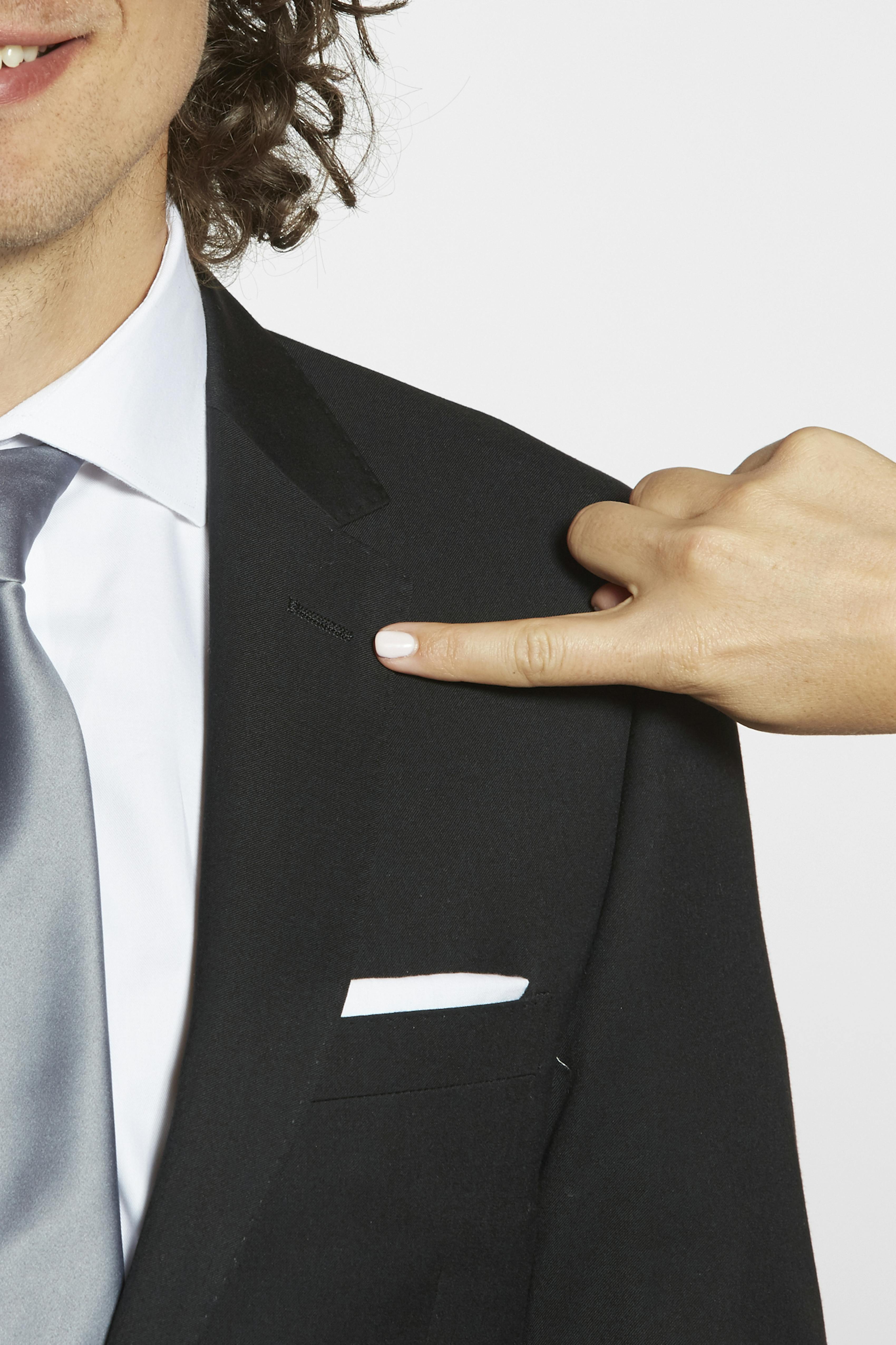
2. Ensure a tight grip
Placing your thumb under the backside of the lapel, use your index and middle finger to pinch the stem and lapel together. Be firm with this to ensure the flower doesn’t move as you turn the lapel over to start the pinning process. As you’re about to discover, all the action happens behind the lapel so it’s important have a good hold on both the boutonniere and the lapel.
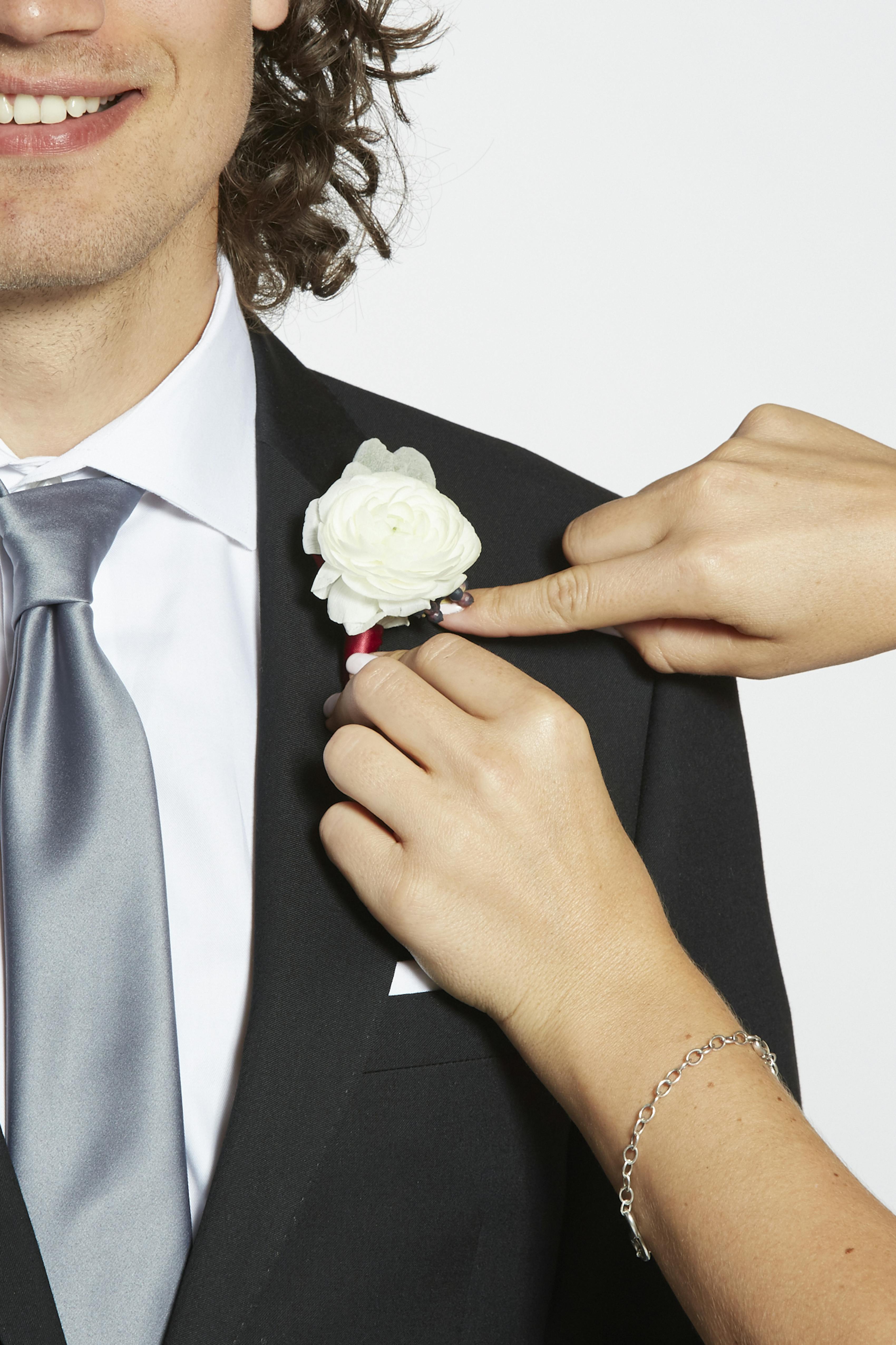
3. Secure the boutonnière
Once the boutonniere is firmly placed and you have a good hold on it, you will gently fold the lapel back exposing the underside of the lapel. From the outer edge of the lapel, you will push the pin through the fabric into the top of the ribbon covered stem. You will continue to push the pin through the stem towards the inner edge of the lapel until it reappears through the fabric under the lapel. To make sure you don’t poke the gentleman you’re pinning, it’s best to keep the lapel folded back to ensure the pin is only going through the fabric on the underside of the lapel and not through additional layers of his suit, shirt and skin.
When done, the needle will look like a single stitch on the underside of the lapel that goes through the boutonniere. With the right pin placement through the top of the stem where it is thickest, one pin should be sufficient. If you have a really large or heavy boutonniere, you may want to consider using two pins. The second would go a ½” below the first one.
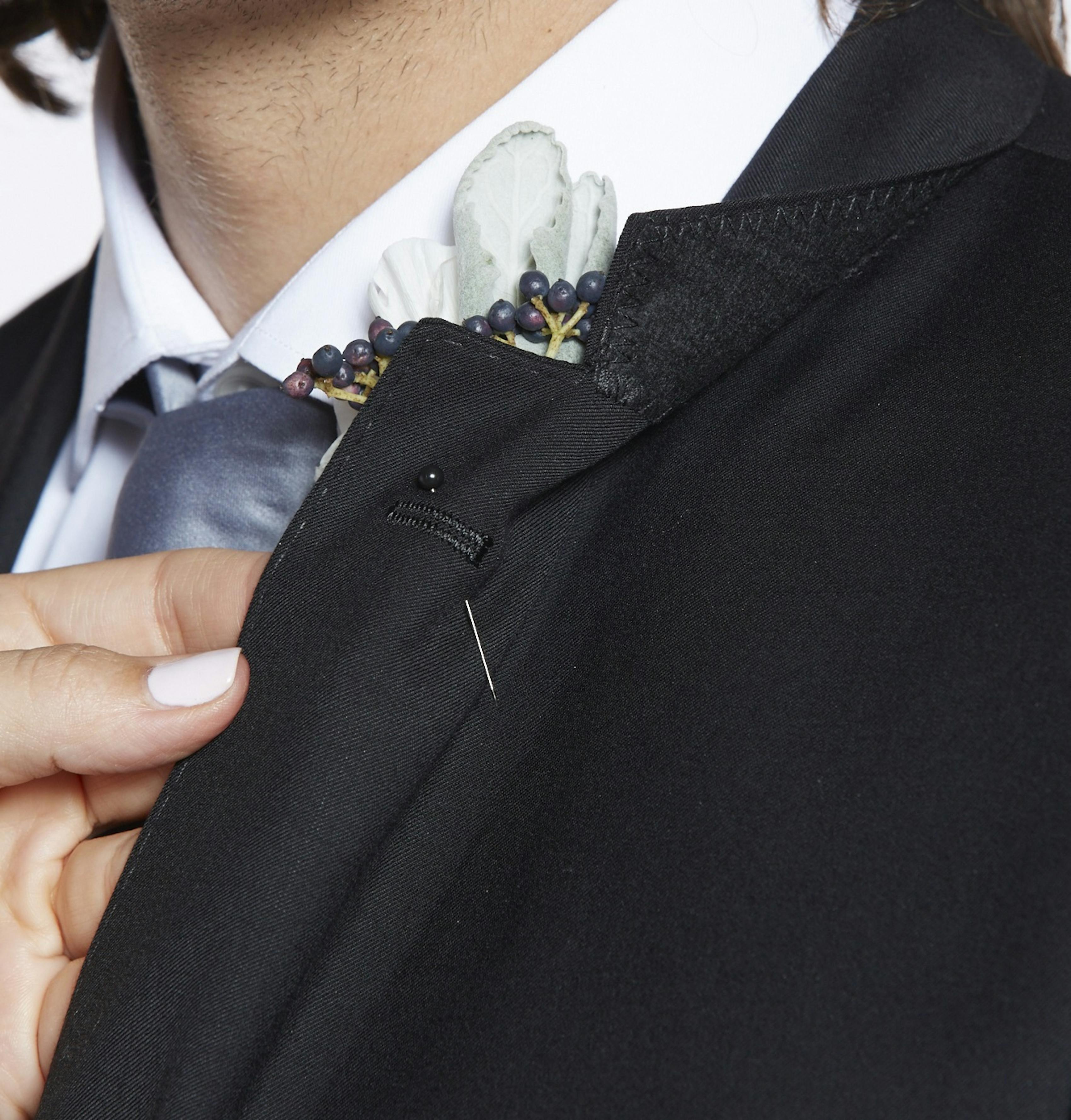
When Do You Wear a Boutonnière?
Boutonnières are versatile accessories that add sophistication to various formal occasions. Understanding when to wear a boutonnière can help you navigate the distinction between formal and semi-formal attire, ensuring you look your best for any event. Whether you're attending prom, a wedding, or a black-tie gala, knowing when to wear a boutonnière can elevate your ensemble and make you stand out. Let's explore some common events where sporting a boutonnière is not only appropriate but also adds to the overall charm and elegance of the occasion:
- Proms and homecoming: Proms and homecoming dances are special events where dressing to impress is a must. Wearing a boutonnière alongside your cufflinks and leather belt adds a classy finishing touch to your attire, making you look sharp and stylish. It's also a great way to coordinate with your date's corsage, enhancing the overall aesthetic appeal of your prom look.
- Weddings: Weddings are perhaps the most common occasion to wear a boutonnière. Whether you're a groom, groomsman, or guest, a boutonnière adds a touch of elegance to your formalwear while complementing the theme or color scheme of the wedding. It's a subtle yet meaningful accessory that signifies your participation in the celebration of love and union.
- Galas and charity events: Galas and charity events often call for sophistication, and a boutonnière is a perfect addition to your look. It not only demonstrates your attention to detail but also shows respect for the occasion and the cause being supported. When designing a boutonnière, you can match the accompanying ribbon colors to the charity or fundraiser’s colors to help raise awareness.
- Award ceremonies: Whether you're attending an awards banquet or a red-carpet event, wearing a boutonnière adds a touch of glamour and prestige to your outfit. It symbolizes your recognition of the significance of the occasion and your respect for the achievements being celebrated. Plus, it's a subtle way to express your personal style and flair while mingling with other guests.
- Graduation ceremonies: Graduation ceremonies are a significant milestone, and wearing a boutonnière adds a touch of celebration to the occasion. It's symbolic of achievement, signaling the transition to the next chapter of your life. Whether you're the graduate or a proud family member, a boutonnière adds an extra layer of pride and joy to the memorable event.
- Black-tie events: Black-tie events demand a high level of formal attire, and a boutonnière alongside your cufflinks and leather belt is a must-have accessory for such occasions. It adds a pop of color and personality to your tuxedo or dinner jacket, enhancing your overall look. Whether you're attending a gala, a ball, or a formal dinner party, a well-chosen boutonnière completes your ensemble with finesse.
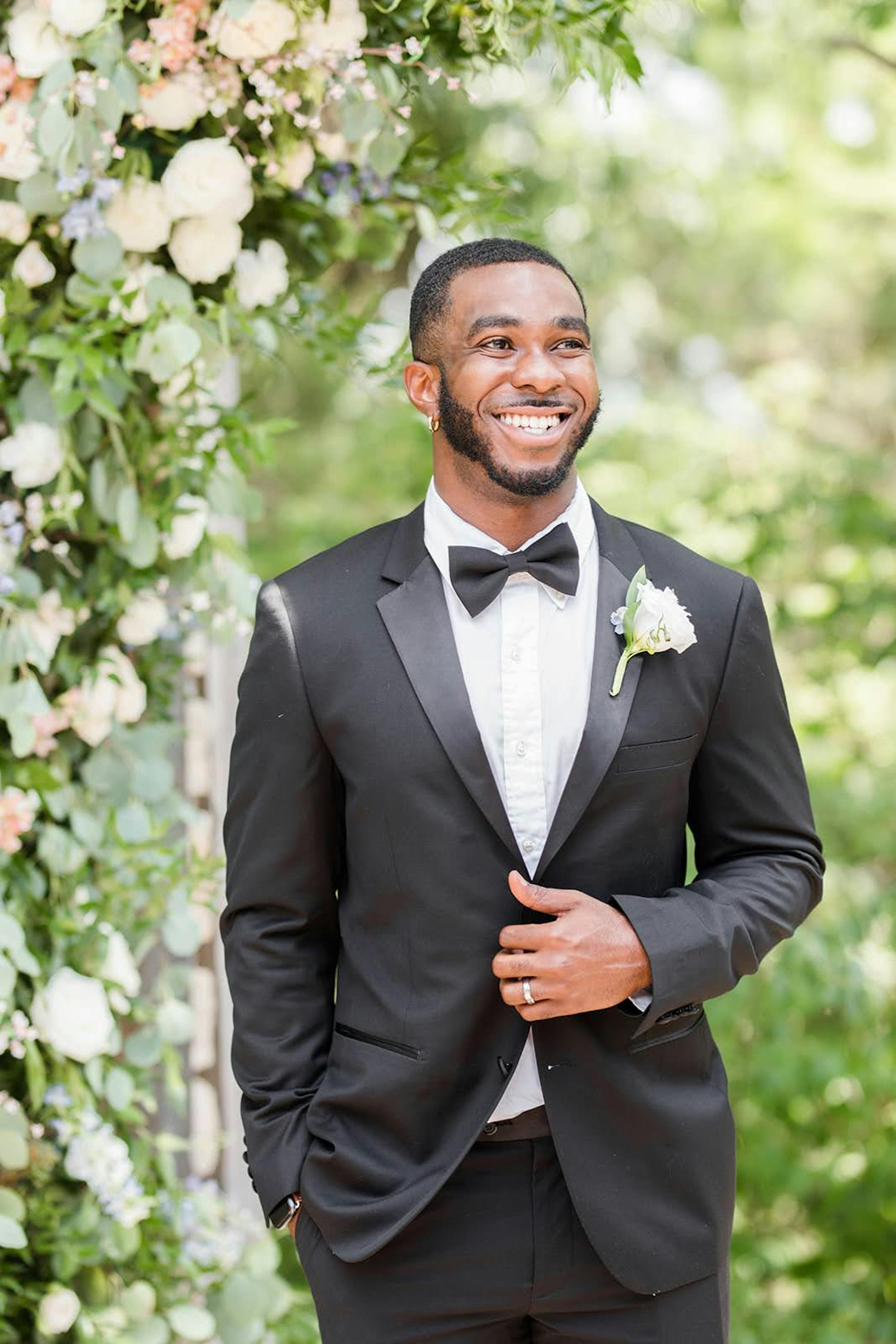
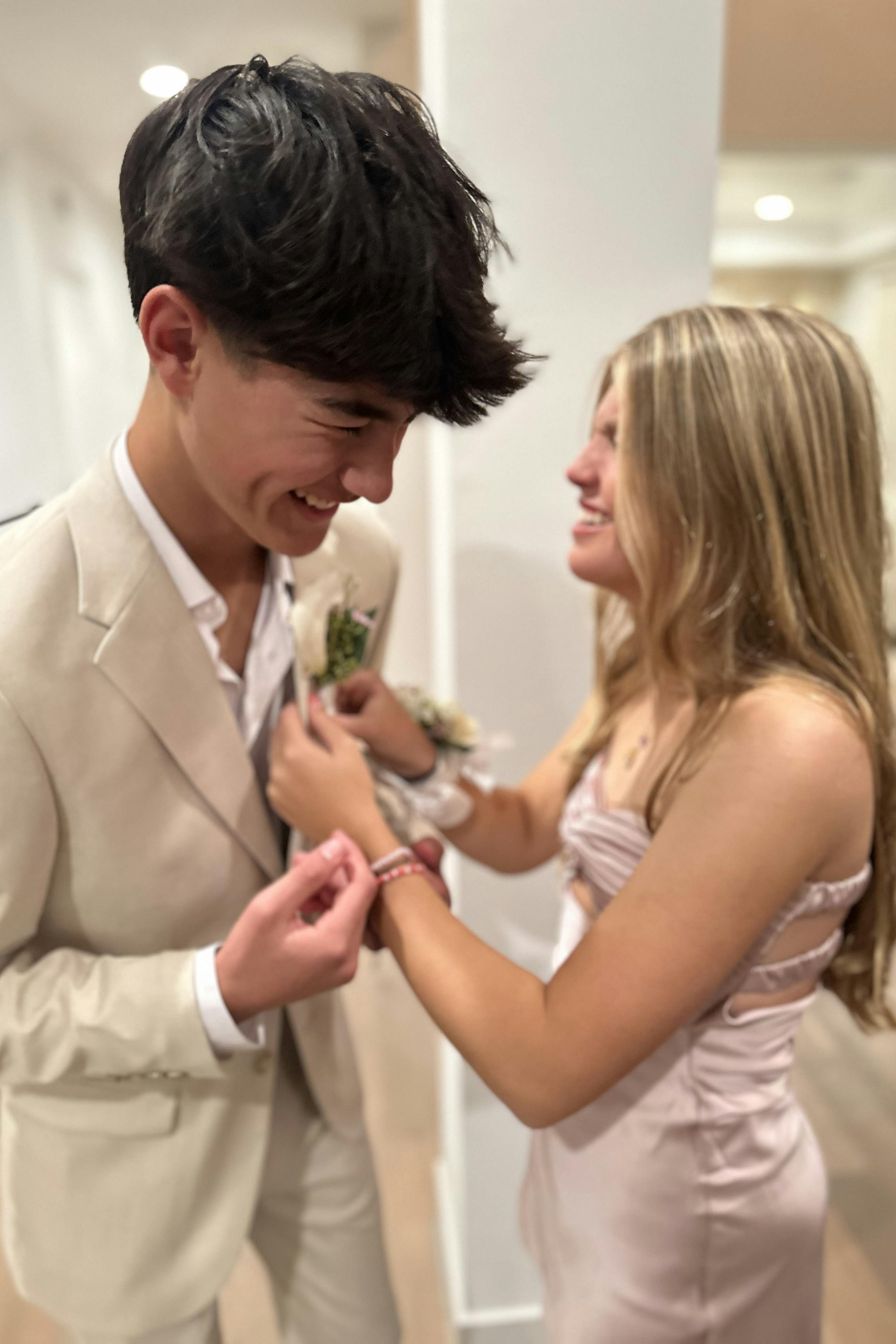
Boutonnière FAQs
Does a girl get a guy a boutonnière?
Traditionally, for events like prom or homecoming, it's common for the girl to get the guy a boutonnière, while the guy gets the girl a corsage. However, couples can also choose these accessories together to ensure they match and complement each other's outfits perfectly. It's a chance for both partners to contribute to the overall look and feel of the event.
What is the difference between a boutonnière and a corsage?
The main difference between a boutonnière and a corsage lies in their placement and size. A boutonnière is a small floral arrangement typically worn by men on the left lapel of a jacket, while a corsage is a larger arrangement worn by women on the wrist or pinned to the dress. Additionally, boutonnières are usually simpler in design and smaller in size compared to corsages, which can be more elaborate. For those looking for boutonnière alternatives, corsages can sometimes be worn on the lapel as well, offering a more substantial floral accessory.
How much does a boutonnière cost?
The cost of a boutonnière can vary depending on several factors, like the type of flowers chosen, the complexity of the design, and any additional embellishments. Generally, boutonnières range between $10 and $20. Factors that can affect the price include the rarity or seasonality of the flowers, whether the boutonnière is made by a professional florist or DIY, and any special requests for custom designs or premium flowers. While simple boutonnières made with common flowers tend to be more affordable, more intricate designs or specialty blooms may increase the cost. However, regardless of the price, a well-chosen boutonnière adds a touch of elegance and style to any formal ensemble.
Can you wear a boutonnière with a pocket square?
Pairing a boutonnière with a pocket square can elevate your formal ensemble to the next level. Here are some styling tips to ensure a cohesive and polished look:
- Coordinate Colors: Choose a pocket square that complements the colors of your boutonnière. Opt for harmonious or complementary hues to create a cohesive look.
- Consider Patterns: If your boutonnière features a solid color, you can add visual interest with a patterned pocket square, or vice versa. Just make sure the patterns don't clash.
- Mind the Fabric: Pay attention to the fabric of both the boutonnière and pocket square. For example, a silk pocket square pairs well with a silk boutonnière for a luxe finish, while a linen pocket square complements a more casual boutonnière.
- Placement: When wearing both a boutonnière and a pocket square, ensure they don't compete for attention. Place the boutonnière on the left lapel and the pocket square in the breast pocket of your jacket. Experiment with different folds for the pocket square to find a style that suits you. If you're not sure how to fold a pocket square, there are plenty of tutorials available online demonstrating various folding techniques.
- Balance: Aim for balance in your overall look. If your boutonnière is particularly large or elaborate, opt for a simpler fold or pattern for your pocket square to avoid overwhelming the outfit, and vice versa.
Yes. Although many couples choose one or the other, there is no reason a boutonnière and a pocket square can’t complement one another.
How do you care for a boutonnière before a wedding?
Ideally, your florist will deliver your boutonnieres and other flowers day of, right before they are ready to be attached to your jacket. If they are in your possession the night before, store them gently in the refrigerator close to the door. If you need to freshen them up day of, use a spray bottle to spray cool water on the stem and gently dry on a tissue before placing on your suit or tuxedo.
What is the right boutonnière size?
The flowers used in the boutonnieres should complement the bridal bouquets and also compliment the size of the gentleman wearing it. For example, a small rose on its own may not look fitting on a larger groomsman, but may be perfect for the ring bearer.
How do you pin a boutonnière without a button hole?
Because tuxedos have a satin lapel, they don’t have this helpful landmark. For notch lapel tuxedos, you can use the bottom edge of the notch where the satin fabric begins as a guide and center the base of the flower/start of the ribbon covered stem about 1.5” from the top of this satin edge of the lapel. Shawl lapels are a bit more difficult because they are one continuous piece of satin. For this reason, we look to the buttons on the shirt to guide placement, specifically the second button from the top of the shirt. This will be the highest fully exposed button. On a shawl lapel, the boutonniere should be placed with the base of the flower even to this button with the stem aligned with the lapel edges.
Does it matter if you don’t pin a boutonnière toward the top of the stem?
Yes, it does matter. Pinning it in the middle of the stem is not a secure placement and will cause the flower to flop around. Putting the pin through the top of the stem where the ribbon begins and stems are thickest is the most secure position.
How can you incorporate the colors of a wedding into a boutonnière?
There are so many ways to incorporate wedding colors into your florals. Flowers vary by season and you have probably chosen your wedding colors based on the time of year and formality of your event. For example, burgundy bridesmaids’ dresses are stunning next to a groomsman in a black suit with a burgundy calla lily boutonniere. Color can also be added in the ribbon choice.
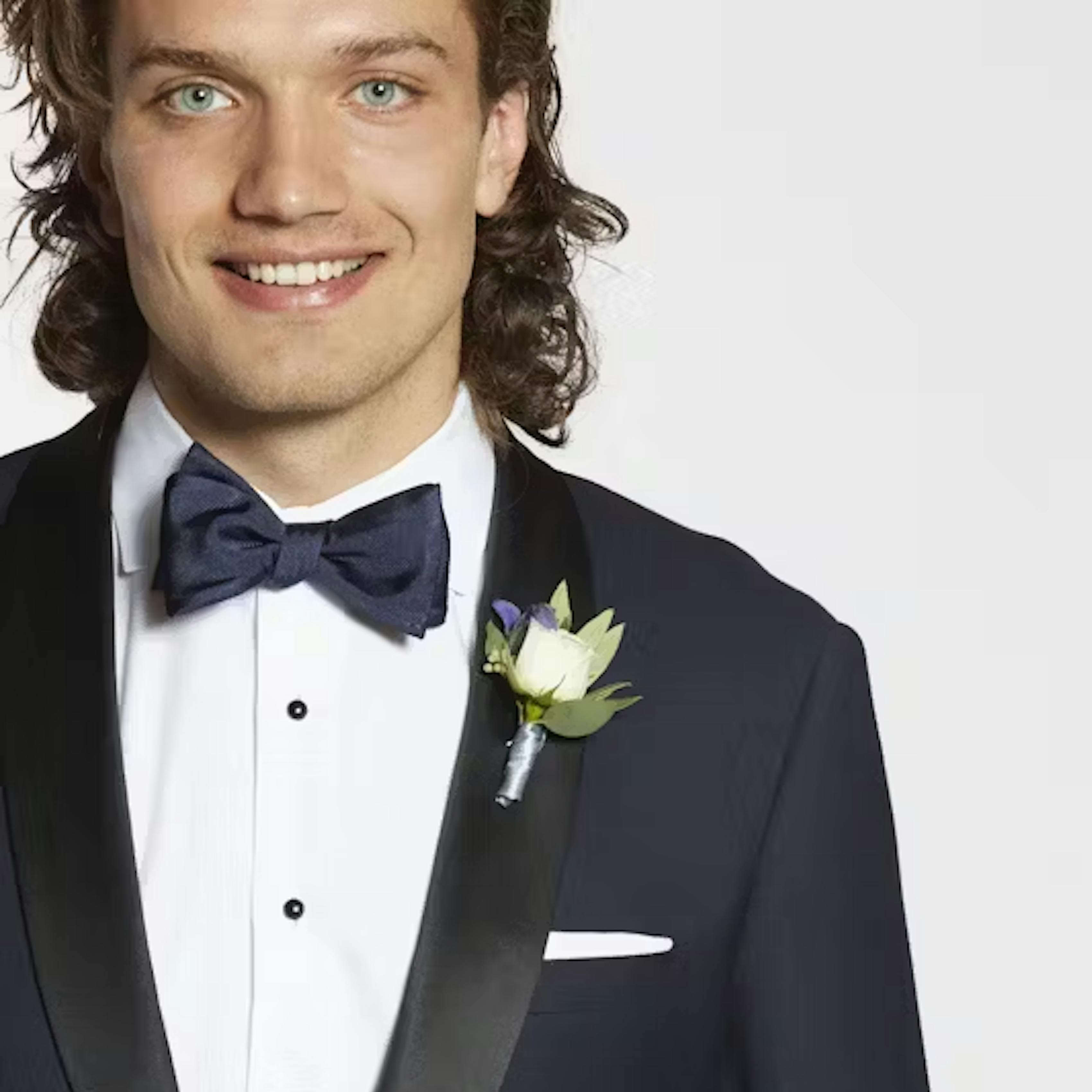
Pinning It All Together: Getting the Perfect Boutonnière Placement
Achieving the perfect boutonnière placement is all about attention to detail and coordination. Remember to place it on the left lapel, slightly above the heart, and ensure it complements your overall ensemble. At SuitShop, we understand the importance of every detail, offering a wide selection of suits, tuxedos, and accessories to suit any occasion. Whether you're choosing wedding suit styles or looking for the perfect fit, our Fit Finder and Fit Guide are here to help you look and feel your best. With SuitShop, you can confidently step out in style for your next event, knowing that every element of your attire has been carefully curated for perfection.

Diana Ganz
Diana Ganz is the co-founder of SuitShop. Being a passionate advocate for the brand, Diana oversees marketing and branding efforts to bring maximum visibil...


